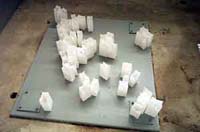For three months I have been wading in the dust and “juices” of the waste ocean. This has been an overwhelming (and sometimes gross) task. I have had to adjust to the noise, the smell, the birds and various vermin, the diesel exhaust, the loud whining of big machines scooping up trash destined for the landfill, a stubborn little feral cat who has made the studio her home and dust, dust, dust.
The dump has been my laboratory to study the thing that I know well, American consumer culture, and the subject of previous work. My first experiments here included collecting the dust (“White Study #1- dust collecting) because I was being forced to collect it no matter how much I vacuumed. This led to an exploration of whiteness (that I will continue after this residency)—white things, the color white and its meanings in American culture (cleanliness, notions of innocence, ideas of purity, facism). As I gathered an inventory, different groupings of things began to tell stories and jokes about the cultural and political subtexts of childhood, machines, and tactile, physical experience. I hauled a lot of materials for many different reasons:
1) because I liked it for its color or shape;
2) because I felt some need to “save”, i.e., “how could such a good thing go to waste?”
3) because I thought I “needed” it;
4) because I thought the object was actually useful;
5) because I was feeling greedy;
6) because I was overwhelmed.
Junk fishing oddly became more about getting out of my head and noticing my impulses and less about acquiring something to possess it. The large majority of objects I have collected will be given away or returned to the heap from whence they came.
Artist Statement (prior to residency)
I am exploring constructions and symbols of cultural identity through the everyday and often invisible aspects of culture. My interest in visibilizing culture comes from having felt the suffocating power of silence and denial in a community continually recovering from forced relocation by the U.S. government during World War II. I use familiar forms and images to expose and question cultural values, how we raise children and how we live on a daily basis. I have chosen the whirlygig, made with recycled redwood, to recount both personal and national events and states of mind. The whirlygig is a “folk art” garden sculpture often powered by the wind. It is the “pull yourself up by your bootstraps” medium of self-expression that has traditionally illustrated mundane activities such as a man fishing or a woman milking a cow.
Because the whirlygig is a symbol of the individual American voice and the work ethic, it has been a perfect vehicle to lay open cultural messages that are insidiously implanted in the American landscape, such as the celebration of state violence or the fabrication of middle-class happiness.
I have also adapted versions of it to materialize the notion of making “toys for a historically accurate childhood,” playful objects that reflect my perspective of American culture. My whirlygigs critique the fascistic, hidden or denied aspects of my country while engaging the viewer in an oxymoronically amusing activity. In my own way, I embrace these forms as part of my American inheritance.
My most recent work, developed while in residency in Japan, explores the waribashi, the disposable wooden chopstick. The sculpture installation, “Tsuyu (Rainy Season),” consists of over 15,000 recycled waribashi collected from small noodle shops in Tokyo. The installation includes a looped recording of chopsticks falling and my washing them by hand. Chopsticks pervade Japanese culture; over 110 million waribashi are used and thrown out daily in a nation that is the world’s largest consumer of wood products.
Wooden chopsticks are thus a powerful cultural metaphor for consumerism and literal human consumption everyday, and yet the Japanese rarely see them en masse. They are a reminder of Japanese-ness to the Japanese in the same way that automobiles remind us of our American-ness; they appear inherent to our way of life despite the impending consequences of their habitual use.
I invite the viewer to engage with the emotional-psychic space between the seriousness of today’s events and the lightness of life, between angry cynicism and informed optimism. I aim to challenge the viewer to look at their participation in the culture by facilitating an experience thorough interactivity, environments and familiar objects. I am searching for answers to my own questions. I hope that through playfulness, we may be able to see more about ourselves.
Photos and press release for this artist.
Residency: January 2001 - April 2001
Art Exhibition: Saturday, April 21
